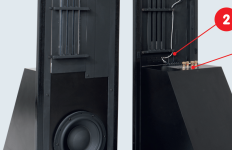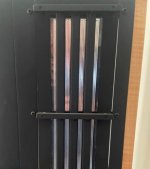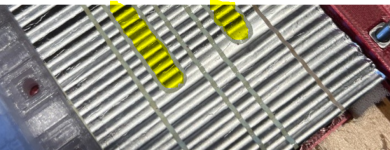Thanks båndsei.I used this "glue" for my cutting matt https://www.computersalg.dk/i/10246...t_gd=F344CCFDC899A7A53458B3DBB57777C3D2D1FFE7
I sprayed it on some 0,5mm plastic sheets
Actually it looked like this
https://www.retailonline.dk/produkt...OcdbdQKR53fRTO58o1bwP9tTN0dN-UARoC1nUQAvD_BwE
Bernt
Yes, I remember these from my ribbon days.
I currently use 3M Super 77 with paper as cutting mat, but it is way too stiff.
I will try the ReMount on plastic.
Yeah, it sure doesn't look promising based on your model results. It has been 25 years since I saw a pair of LFT-8s in person. The front and back magnetic channels were definitely staggered (3 in front, 4 in back) and really confused me as to how the magnetic field must look in the plane of the diaphragm. Here are some pics from archive showing position of front and rear channels of magnets and the voice coil pattern.I hope that I got it right this time.
There's a constant force up or down (B,n) and most uneven usable force (B,t).
I still doesn't see the benefit of this configuration.


Speaking of channels...I guess you still need to add the ferrous metal channels around each of the magnets and I'm guessing the back plates you currently have should be removed or made non-ferrous. This would bring S magnetic pole around and position it along side the N pole on top and vice versa on bottom. Perhaps that is key in getting the improvement in field uniformity the patent describes.
Do you also cut long membranes using the Silhouette Cameo roll feeder, that is, using non standard cutting mats?I used this "glue" for my cutting matt https://www.computersalg.dk/i/10246...t_gd=F344CCFDC899A7A53458B3DBB57777C3D2D1FFE7
I sprayed it on some 0,5mm plastic sheets
Actually it looked like this
https://www.retailonline.dk/produkt...OcdbdQKR53fRTO58o1bwP9tTN0dN-UARoC1nUQAvD_BwE
Bernt
Do you prevent the cutter to travel back and forth for every vertical cut?
Well, that's the method that I'm using:I used A4 sheets of plastic and made some with 2 A4 sheets taped to one piece app 210x600 mm
I made AMT diaphragm´s
I changed size of cutting board like this:
But even for this short 305 mm test membrane the cut is ruined because of the media is going back and forth all the way.
At full lenght, 2400 mm, this will be a disaster.
Disclaimer: I haven't tested this myself yet!
Inkscape seems to have a silhouette cameo plugin (https://github.com/fablabnbg/inkscape-silhouette) for which the topmost feature is:
Inkscape seems to have a silhouette cameo plugin (https://github.com/fablabnbg/inkscape-silhouette) for which the topmost feature is:
- Path sorting for monotonic cut. We limit backwards movement to only a few millimeters, and make the knive pull only towards sharp corners so that most designs can be done without a cutting mat!
Thanks OllBoll, that's exactly what we need.
I'll try this immediately, hopefully there's bluetooth support as well.
I'll try this immediately, hopefully there's bluetooth support as well.
Well, it turned into a deep rabbit hole with special usb drivers and python libs installations. The plugin is there, but it doesn’t connect to the Silhouette.
No Bluetooth support as far as I can see.
No Bluetooth support as far as I can see.
Experiments have shown that the straight forward method works; the Silhouette Cameo 5 will be able to cut 2.2 meter long membranes.
Here its cutting only 280 mm:
After I weeded it, it came out really nice:

I'm using milk carton as a cutting mat, on that I have glued the aluminium foil using the 3M ReMount spray glue.
That glue gives me the chance to reuse the milk carton.
Then I use 3M 77 glue on the foil and glue in this case a PEN film:

I have discovered that the 7 µm foil is not "winning" over the PET or PEN film when corrugateing, so I've put on another layer of 7 µm foil.
Here's a comparision between a 20 µm 3M 74 film to the left and a 12 µm PEN film to the right:

The PEN film is less noisy, but doesn't hold the corrugation that well.
The weight for the moving part of the membrane is 1.27 for PET and 1.10 grams for PEN
The former means that a 2.2 meter long membrane weighs 10 grams.
The moving part is then 990 square centimeters.
The membrane lies freely between dust sealing strips:



The dust sealing strip doesn't seem to flatten the corrugation and has hopefully some compliance for the membrane.
I will now test some more films: BOPP and some PET of different thicknesses among them a metalized film.
Here its cutting only 280 mm:
After I weeded it, it came out really nice:
I'm using milk carton as a cutting mat, on that I have glued the aluminium foil using the 3M ReMount spray glue.
That glue gives me the chance to reuse the milk carton.
Then I use 3M 77 glue on the foil and glue in this case a PEN film:
I have discovered that the 7 µm foil is not "winning" over the PET or PEN film when corrugateing, so I've put on another layer of 7 µm foil.
Here's a comparision between a 20 µm 3M 74 film to the left and a 12 µm PEN film to the right:
The PEN film is less noisy, but doesn't hold the corrugation that well.
The weight for the moving part of the membrane is 1.27 for PET and 1.10 grams for PEN
The former means that a 2.2 meter long membrane weighs 10 grams.
The moving part is then 990 square centimeters.
The membrane lies freely between dust sealing strips:
The dust sealing strip doesn't seem to flatten the corrugation and has hopefully some compliance for the membrane.
I will now test some more films: BOPP and some PET of different thicknesses among them a metalized film.
Nice work!
Especially interesting that you published a video of the cutter doing its thing. You are using Silhouette Studio?
And nice that the dust sealing foam seems to work well. That got me a crazy idea: if I remember correctly you have a CNC? If it turns out that you need extra support to hold up the corrugations when going the full membrane length: I wonder if it would be possible to mill the foam to add indentions for the corrugations to lie in?
Especially interesting that you published a video of the cutter doing its thing. You are using Silhouette Studio?
And nice that the dust sealing foam seems to work well. That got me a crazy idea: if I remember correctly you have a CNC? If it turns out that you need extra support to hold up the corrugations when going the full membrane length: I wonder if it would be possible to mill the foam to add indentions for the corrugations to lie in?
Thank you OllBoll.
I design the membranes using Autodesk Fusion:

I export the sketch as a dfx and then open it in Silhouette Studio and then send it to the cutter:

No, I don't have a general CNC but I have a Prusa 3D printer, a Silhouette Cameo cutter, a Creality laser engraver and a diy plasma cutter.
I'm afraid none of them can do what you are proposing.
I don't think it will be necessary to work on the foam; it's compliant enough for the corrugation and at the same time have enough friction to hold the membrane sideways.
I design the membranes using Autodesk Fusion:
I export the sketch as a dfx and then open it in Silhouette Studio and then send it to the cutter:
No, I don't have a general CNC but I have a Prusa 3D printer, a Silhouette Cameo cutter, a Creality laser engraver and a diy plasma cutter.
I'm afraid none of them can do what you are proposing.
I don't think it will be necessary to work on the foam; it's compliant enough for the corrugation and at the same time have enough friction to hold the membrane sideways.
Nice Work - I was wondering where you purchased your Pen filmI have discovered that the 7 µm foil is not "winning" over the PET or PEN film when corrugateing, so I've put on another layer of 7 µm foil.
Thanks els42.
I bought Teonex through AliExpress:

If youbuy there, make sure that you'll get the correct amount.
So better contact the seller before you buy.
I bought Teonex through AliExpress:
If youbuy there, make sure that you'll get the correct amount.
So better contact the seller before you buy.
I put a piece of a membrane made of BOPP into a vise to illustrate the compression the foam makes to the membrane's corrugation.
First not compressed:

And then compressed to the same width it will have in the motor:

The membrane is not in the middle to the left, I guess it's because there's more foam above than below the membrane.
First not compressed:
And then compressed to the same width it will have in the motor:
The membrane is not in the middle to the left, I guess it's because there's more foam above than below the membrane.
That demonstration is amazingly helpful! In hindsight it seems obvious but I didn't think of it. Of course the corrugations should be stronger than the foam. And if it is a problem then you can always go to a softer foam and / or use a corrugation wheel with more teeth resulting in more corrugations per unit of length thus more stiffness.
- Home
- Loudspeakers
- Planars & Exotics
- Yet another Planar Magnetic Line Source, the SMAPPP

